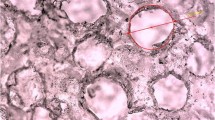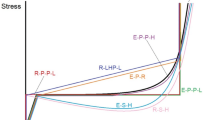Abstract
Silicone foam is used as a shock mitigation material in a variety of systems to protect internal components from being damaged during external shock or impact loading. Characterizing the shock mitigation response of silicone foam under a variety of scenarios is a critical step in designing and/or evaluating new shock mitigation systems. In this study, a Kolsky bar with pre-compression capability was used with a passive radial confinement tube to subject the sample to various levels of pre-strain followed by impact loading. The effects of both pre-strain and impact velocity on impact energy dissipation behavior were investigated for silicone foam. The energy dissipation response of silicone foam is compared to a silicone rubber manufactured using the same processing methods to understand the energy dissipation characteristics of silicone foams transitioning to a silicone rubber. The final density of the foam or rubber plays a key role in both the total energy dissipation ratio in the time domain and the energy dissipation ratio as a function of frequency in the frequency domain.









Similar content being viewed by others
References
Zhou CY, Yu TX (2009) Analytical models for shock isolation of typical components in portable electronics. Int J Impact Eng 36:1377–1384. https://doi.org/10.1016/j.ijimpeng.2009.03.013
Benning CJ (1969) Effect of cell structures in polyethylene foam on shock mitigation. J Cell Plast 5(1):40–45. https://doi.org/10.1177/0021955x6900500105
Zhang Z, Ming F, Zhang A (2014) Damage characteristics of coated cylindrical shells subjected to underwater contact explosion. Shock Vib 2014:764607 1–15. https://doi.org/10.1155/2014/763607
Rabe JA, Spells S, Rasch DM, Homan GR, Lee CL (1981) Evaluation of silicone foam for flat plate solar collector insulation. Sol Energ Mater 4:159–168. https://doi.org/10.1016/0165-1633(81)90039-3
Blood RP, Ploger JD, Yost MG, Ching RP, Johnson PW (2010) Whole body vibration exposures in metropolitan bus drivers: a comparison of three seats. J Sound Vib 329:109–120. https://doi.org/10.1016/j.jsv.2009.08.030
Hu WJ, Huang XC, Fan ZG, Si PG (2014) A phenomenological constitutive model for silicone foam under large deformations. In: International conference on mechanics and materials engineering (ICMME 2014)
Lu WY (2015) Compression of silicone foams. In: Society for experimental mechanics conference. https://doi.org/10.1007/978-3-319-21762-8_27
Sanborn B, Song B (2019) Poisson’s ratio of a hyperelastic foam under quasi-static and dynamic loading. Int J Impact Eng 123:48–55. https://doi.org/10.1016/j.ijimpeng.2018.06.001
Gibson L, Ashby F (1999) Cellular solids: structure and properties, 2nd Edition. Cambridge University Press, Cambridge
Song B, Nelson K (2015) Dynamic characterization of frequency response of shock mitigation of a polymethylene diisocyanate (PMDI) based rigid polyurethane foam. Lat Am J Solids Struct 12:1790–1806. https://doi.org/10.1590/1679-78251585
Sanborn B, Song B, Smith S (2016) Pre-strain effect on frequency-based impact energy dissipation through a silicone foam pad for shock mitigation. J Dyn Behav Mater 2:138–145. https://doi.org/10.1007/s40870-015-0043-1
Sanborn B, Song B, Nishida E, Knight M (2017) Experimental evaluation of a low-pass shock isolation performance of elastomers using frequency-based Kolsky bar analyses. Lat Am J Solids Struct 14(3):560–574. https://doi.org/10.1007/s40870-015-0043-1
Nie X, Song B, Loeffler CM (2015) A novel splitting-beam laser extensometer technique for Kolsky tension bar experiment. J Dyn Behav Mater 1:70–74. https://doi.org/10.1007/s40870-015-0005-7
Beccu B, Lundberg B (1987) Transmission and dissipation of stress wave energy at a percussive drill rod joint. Int J Impact Eng 6(3):157–173. https://doi.org/10.1016/0734-743X(87)90019-4
Song B, Chen W (2006) Energy for specimen deformation in a split Hopkinson pressure bar experiment. Exp Mech 46:407–410. https://doi.org/10.1007/s11340-006-6420-x
Chen W, Song B (2011) Split Hopkinson (Kolsky) bar. Design, testing and applications. Springer, New York, pp 217–219. https://doi.org/10.1007/978-1-4419-7982-7_6
Acknowledgements
Sandia National Laboratories is a multimission laboratory managed and operated by National Technology and Engineering Solutions of Sandia, LLC., a wholly owned subsidiary of Honeywell International, Inc., for the U.S. Department of Energy’s National Nuclear Security Administration under contract DE-NA-0003525. The views expressed in the article do not necessarily represent the views of the U.S. Department of Energy or the United States Government.
Author information
Authors and Affiliations
Corresponding author
Additional information
Mr. Brett Sanborn and Dr. Bo Song are the members of the Society for Experimental Mechanics.
Rights and permissions
About this article
Cite this article
Sanborn, B., Song, B. Energy Dissipation Characteristics in Pre-strained Silicone Foam Transitioning to Silicone Rubber. J. dynamic behavior mater. 5, 51–58 (2019). https://doi.org/10.1007/s40870-019-00183-1
Received:
Accepted:
Published:
Issue Date:
DOI: https://doi.org/10.1007/s40870-019-00183-1




